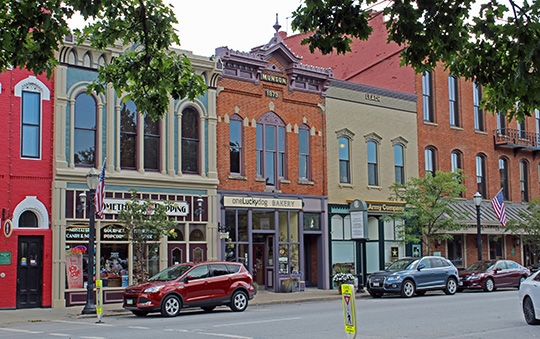About Miamisburg
Here’s a little bit about the city of Miamisburg if you are looking for a Tax Attorney Miamisburg Ohio.
Miamisburg (/maɪˈæmizbɜːrɡ/ my-AM-eez-burg) is a city in Montgomery County, Ohio. The population was 20,181 at the time of the 2010 census. A suburb of Dayton. It is part of the Dayton metropolitan area. Miamisburg is known for its large industry (mainly for its nuclear operations during World War II) and retail factors (such as the Dayton Mall) commercial business area, which is partially located in Miami Township, and as the home to the Miamisburg Mound. Miamisburg borders Miami Township, Springboro, and West Carrollton. The sister city of Miamisburg is Owen Sound, Ontario, Canada.
European-Americans started calling their first community “Hole’s Station” circa 1797, when Zechariah Hole settled there with his family from Virginia and built a stockade on the west bank of the Miami River opposite the mouth of Bear Creek. The stockade attracted squatters, surveying parties, and other settlers who had taken grants to live in the local cabins until they could build their own; hence the little community became known as “Hole’s Station”. Settlers came west primarily from Pennsylvania. By 1822, the unincorporated community had become a village; it achieved city status in the 1920s.
By 1827, the Miami and Erie Canal was under construction through the community, which improved transportation of people and goods through the region. The formal opening took place in January 1829, when the Governor Brown was the first packet boat to go through the settlement. Also that year the first boats from Cincinnati had arrived and passed through Miamisburg to get to Dayton. By 1834 the canal had been extended to Piqua, and many businesses along the river grew. The 1840s and the 1850s were brought the best of times to the canals.
George Kinder, a local resident, shipped bags of food to Ireland during its Great Famine; these also contained his address, with ads saying that he was hiring immigrant workers. Some Irish immigrants did come to Miamisburg and surrounding cities in search of work. By the early 20th century, however, the canal was abandoned. Later, highways carried most of the local traffic.
Miamisburg was the site of one of the first post-war U.S Atomic Energy Commission (AEC) facilities, beginning in 1947. The Dayton area had supported numerous secret operations for the War Department during World War II. As the war ended, the majority of these operations were moved to the Miamisburg Mound Laboratory, which was operated by the Monsanto Chemical Company. The Mound Labs were to monitor all aspects of the US nuclear defense stockpile.
The Mound Plant, built in 1947, was situated on a 306-acre (124 ha) site in the city 10 miles (16 km) south of Dayton. The workers, who numbered more than 2,000 at the height of the production, made plutonium detonators for nuclear weapons. Their work was very classified. The plant had a small army of security guards and was ringed by chain-link fencing and razor wire. When the Cold War ended, the plant discontinued the detonator work, but it continued to make nuclear power generators for space probes.
In May 1993 U.S Department of Energy decided to end all production at the Mound. This move affected 2,100 employees in the local area. By 1996 cleanup of radioactive and hazardous waste was the main activity at the Plant. The Mound Development Corporation spearheaded the creation of the Mound Advanced Technology Center in the redevelopment of the plant, with the Montgomery County Regional Dispatch Center joining 14 other tenants in March 2009. In December 2010, the Dayton Police Department became the 17th law enforcement agency, along with 11 fire departments, to be dispatched from the regional center.
On September 10, 1978, 15 cars of a Conrail freight train derailed as the result of a hot box, caused by uneven distribution of steel ingots in a gondola loaded at Buffalo, New York by Republic Steel. They demolished a house at the Pearl Street crossing and killed three of its five occupants. As a result of a cooperative investigation by the Miamisburg Police Department and the National Transportation Safety Board, the deaths were ruled homicides by the Montgomery County Coroner.
Eight years later, on July 8, 1986, another train derailed on the CSX Transportation line on the west bank of the river, igniting yellow phosphorus contained in a tanker car. 7,000 local residents were initially evacuated, but during clearing operations the next day another large escape of product resulted in re-ignition of the phosphorus. This led to the evacuation of approximately 30,000 people across southern Montgomery County, the largest evacuation in Ohio history. The resulting thick white cloud engulfed communities as far north as Yellow Springs, Pitchin, and South Vienna. Rolling in like a massive desert dust storm across the horizon, the chemical cloud hugged the ground and blotted out the sun for several minutes before dissipating. 569 persons were treated for “various complaints,” more than $3.5 million in property damages occurred, and more than $1 billion in lawsuits resulted.
A nitric oxide distillation column at a local chemical plant known as Isotec exploded on September 21, 2003, causing school and other events to be cancelled. Isotec is a division of Sigma-Aldrich.
World headquarters of JatroDiesel is in Miamisburg. JatroDiesel manufactures biodiesel equipment and produces biodiesel, a sustainable alternative fuel to diesel. The headquarters of National City Mortgage Corporation, a division of National City Corp. was in Miamisburg. In 2009, PNC Bank purchased National City Bank and converted National City Mortgage into PNC Mortgage. The headquarters for PNC Mortgage moved to Downers Grove, Ill, but much of the servicing division remains in Miamisburg. World headquarters of LexisNexis were in Miamisburg. In 2007, the headquarters moved to New York City, but the operations have remained in Ohio.
In 2018, a time vault was opened to celebrate the city’s 200th birthday.
Miamisburg is the location of a prehistoric Indian burial mound (tumulus), believed to have been built by the Adena culture, about 1000 to 200 BCE. Once serving as an ancient burial site, the mound has become perhaps the most recognizable historic landmark in Miamisburg. It is the largest conical burial mound in Ohio, as of 1848, the mound was 68 feet (21 m) tall and had a circumference of 852 feet (260 m). In a city park at 900 Mound Avenue, it has been designated an Ohio historical site. It is picnic destination and tourist attraction. Visitors can climb to the top of the Mound, via the 116 concrete steps built into its side. It is at coordinates 39.627553°N 84.280889°W.
Due to the growth of the city in the 19th century, many of the older houses in the city are Victorian-style homes. They are concentrated in the neighborhood of “Old Miamisburg” (downtown and riverfront areas). Other architectural styles include Queen Anne, Italianate, and Second Empire-styled buildings. Much of Miami Township has residential housing of single-family homes, which were built during the expanded suburban development typical of the late 20th century, especially the 1970s through the 1990s. Newer houses have been built in the 21st century as some residents have sought higher-priced luxury homes, evidenced in new developments such as Pipestone, Crains Run, Heincke Woods, and Bear Creek.
To encourage and recognize Miamisburg citizens for maintaining the aesthetic appearance (tidiness, landscaping) of their property, the City Beautification Commission selects a number of “City Beautiful Awards” each July, August, and September for both residential and commercial properties. Additionally, the City Beautification Commission also offers awards for high-quality architectural renovation projects and for a number of holiday decoration displays in December.
Numerous community events are held during the year, such as live music and block parties. Every spring, ‘Spring Break in the Burg’ and the ‘Spring Fling’ festival is held downtown in Library Park. On Halloween, ‘Boo in the Burg’ offers special shopping and food specials for patrons. An annual bicycle race known as ‘Tour D’Burg’ is also held every summer in the downtown area.
As of the census of 2010, there were 20,181 people, 7,948 households, and 5,570 families residing in the city. The population density was 1,656.9 inhabitants per square mile (639.7/km2). There were 8,604 housing units at an average density of 706.4 per square mile (272.7/km2). The racial makeup of the city was 93.8% White, 3.0% African American, 0.2% Native American, 1.0% Asian, 0.4% from other races, and 1.5% from two or more races. Hispanic or Latino of any race were 1.6% of the population.
Out of a total of 7,948 households, 35.0% had children under the age of 18 living with them, 53.7% were married couples living together, 12.0% had a female householder with no husband present, 4.4% had a male householder with no wife present, and 29.9% were non-families. 25.4% of all households were made up of individuals, and 11.5% had someone living alone who was 65 years of age or older. The average household size was 2.50 and the average family size was 2.98.
The median age in the city was 40.2 years. 25.1% of residents were under the age of 18; 6.4% were between the ages of 18 and 24; 25% were from 25 to 44; 27.2% were from 45 to 64; and 16.2% were 65 years of age or older. The gender makeup of the city was 47.6% male and 52.4% female.
If you are looking for a tax attorney Miamisburg Ohio, you are at the right spot. Give us a call today at 330-331-7611.









